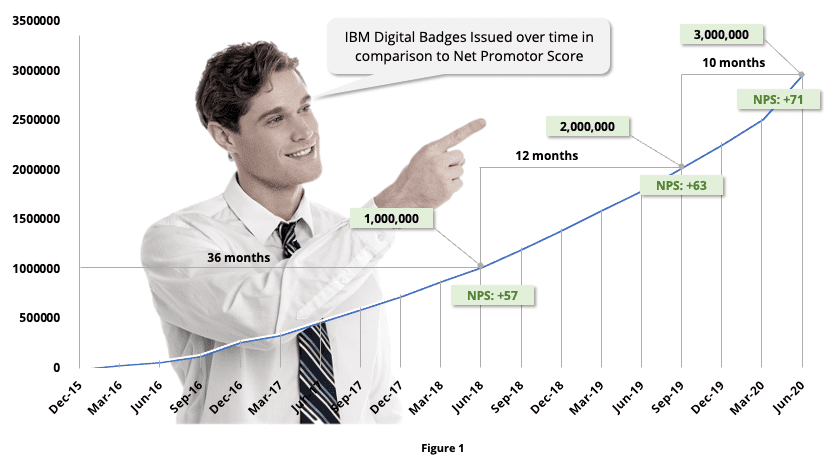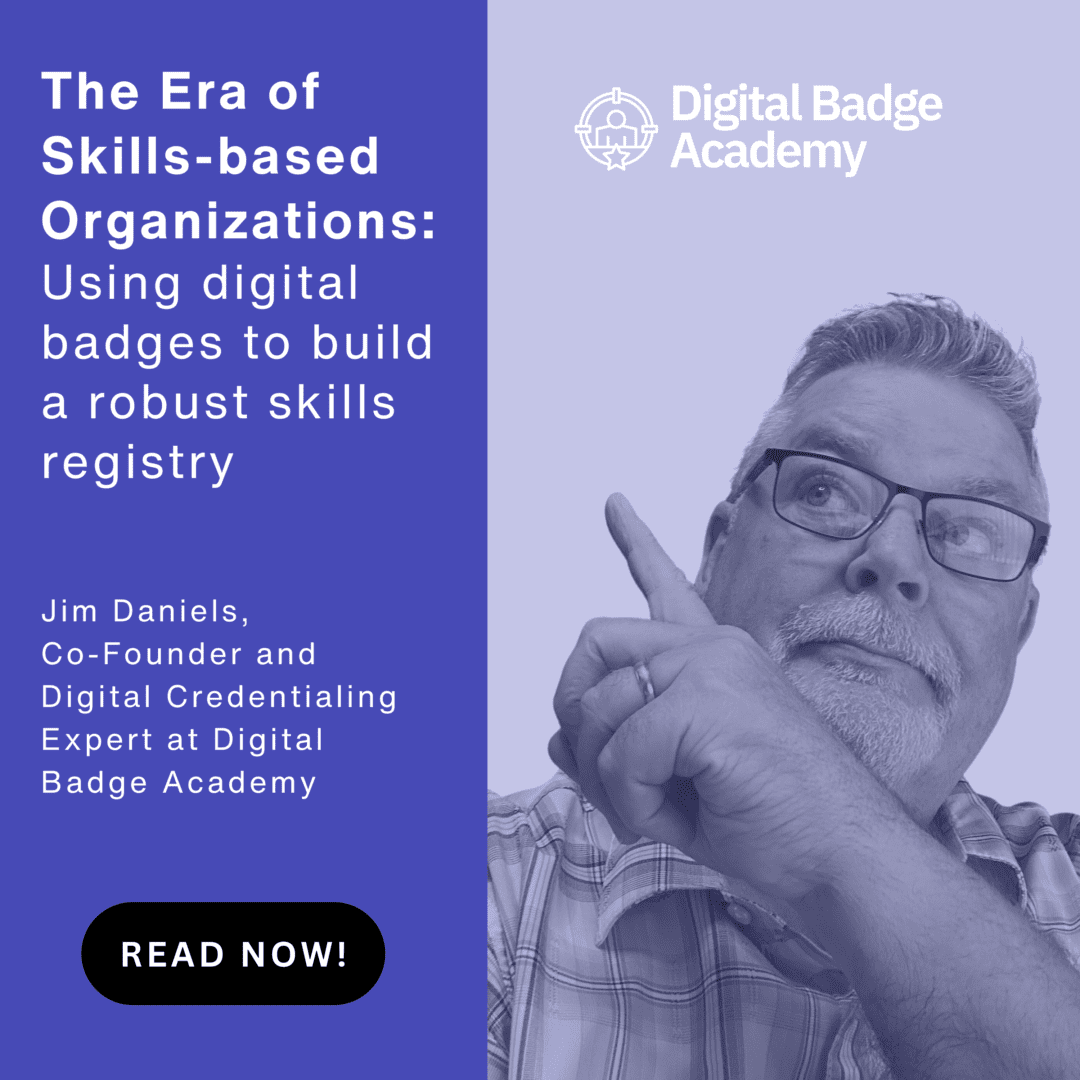Over the past several years, digital badging has gained significant popularity across industry as a valuable form of credentialing. Many companies and organizations have embraced this innovative approach, recognizing its potential for enhancing skill development, recognition, and more recently, as an enabler of skills-based organization transformation. Having spent the better part of seven years building and managing IBM’s global digital credentialing strategy and program operations, I had the privilege of sitting in the drivers seat and gaining invaluable experience about what it means to harness the power of digital badging to help drive skill development and progression in a skills-based economy.
“A constant cadence of measuring, assessing, and adjusting was required to drive real and measurable value for credential issuers, earners, and consumers..”
IBM’s digital credentialing program (a collection of over 200 separate digital credentialing initiatives), has been a resounding success and frequently referenced by other organizations as a blueprint and inspiration for creating their own programs. However, IBM’s digital credentialing success didn’t occur overnight. A constant cadence of measuring, assessing, and adjusting was required to drive real and measurable value for credential issuers, earners, and consumers. This is the single most important priority to establish within a digital badge program governance and operational model and a key factor for any credential program’s success.
There are certainly many other program elements and operational needs that go into building and managing a digital credentialing strategy as large as IBM’s. A program of this scale requires
continuous care and feeding, and most importantly, a framework that can be applied universally across the enterprise regardless of program type or need.
A comprehensive credentialing framework was developed by IBM to represent the full spectrum of what you know, what you can do, and what you have mastered where recognition of skills and abilities are concerned. This can be anything from discrete learning outcomes to advanced levels of professional and technology certifications. Moreover, the organization also utilizes digital badging to recognize diverse types of contributions, including community volunteer programs and technical content authoring.
“The modern worker’s skill set is more fluid than ever before and requires updating existing expertise and learning brand new skills on an almost continuous basis.”
The learning journey is as important as the destination
Many digital credentialing strategies across commercial enterprises focus primarily on formal certification programs. This is a terrific application for badging and a great way to get started
with launching a badge program. But there are other areas where badging can be effectively applied to improve the learner experience. Education and training programs that are part of
the journey toward becoming certified are often lengthy and include important skill development milestones that would benefit from being recognizing with digital credentials. Or perhaps there
are skill development programs that don’t lead to a certification. Whatever the case, there is significant value to be realized when leveraging digital credentialing for the following:
- Completion of ‘key’ Individual courses (hours to days to complete)
- Achievement of critical learning milestones (days to weeks to complete)
- Completion of comprehensive learning programs (weeks to months to complete)
The modern worker’s skill set is more fluid than ever before and requires updating existing expertise and learning brand new skills on an almost continuous basis. And while certification programs work well for aggregating skills recognition into a single validated and verifiable credential, they don’t always cover the full spectrum of skills required in our jobs or have the ability to surface newly acquired skills in real-time. In other words, it’s essential to expand credentialing across the skill development and progression landscape to establish a more complete and current skills registry of knowledge, skills and abilities throughout the organization.
“Ongoing analysis proved that thoughtful and well-structured skills development and recognition programs lead directly to increased learning engagement and completion.”
Who benefits from this approach?
- The credential earner benefits from this approach by having a more complete, verifiable record of their skills investment and proven commitment toward learning.
- The credential issuer achieves greater insight around skills readiness, gaps and trends that can help make smarter decisions on when, where and to whom education activities should be focused.
- Credential consumers can make better informed decisions for ongoing skills development, resource management and mobilization, hiring, promotion and other talent management needs.
These are only a few of the measured observations made over the operational lifespan of IBM’s digital credential program. Ongoing analysis proved that thoughtful and well-structured skills development and recognition programs lead directly to increased learning engagement and completion. I witnessed the enthusiasm of learners who earned an IBM badge through the prolific sharing of their IBM digital badges across internal and public social media channels, and I saw how those actions attracted and motivated others to engage and earn an IBM digital badge for themselves.
The data shown in figure 1. best illustrates these points. It not only visualizes the increased engagement trend over the first few years of IBM’s digital credentialing program as a measure of earned credentials, but it also shows the increase in the program’s Net Promotor Score (NPS) results over much of the same timeline.

Key takeaways
I’ve seen many observations documented and shared over the years that attempt to explain the purpose of badges, how best to utilize them, and other advice that may or may not have been supported by front-line experience or measures of success. To sum things up, here are just a few of my own observations based on over eight years of front-line experience building, managing, or consulting on development of enterprise-level digital credential programs.
- If the achievement or contribution is worthy of being documented and recognized, a business case already exists to at least explore the use badging as a way to handle this need.
- “Too many badges dilute the value of the overall program.” While the risk is real, it is easily avoided with the right framework and credential classification structure in place.
- “Badges are different from certification”. While this was a widely accepted point of view a few years ago, it is no longer the case. In fact, the comparison doesn’t really make sense today. A digital badge – based on the Open Badges standard – is an open-source digital documentation method for capturing detailed information about an achievement and embedding it as metadata into a portable image file for web-based validation and verification. In other words, badges can be used to document anything, including achievement of certification.
- Well-designed credentialing program governance and operational policy is a must for any program incorporating digital badging. Set goals, measure and evaluate, and be willing to make changes. Success may not be instantaneous, but it will follow soon enough if these elements are in place and managed effectively.
- Digital badging programs that include recognition of both small and big achievements are more effective at attracting and engaging participants. This approach is also more effective at helping credential earners build a more detailed personal brand through the badges they earn, and subsequently helping them earn professional eminence among their peers and colleagues.
Digital badges serve an important and growing purpose in business. By expanding the use of badges to recognize more detailed skill development and progression activities, IBM and other successful companies have instilled greater purpose and value into their digital credential programs, improved the learner experience, and have greater insight into talent development and education program outcomes – all of which translate to the ultimate goal of improving organizational performance.
About the author:
Jim Daniels has more than 25 years of combined experience in education and credential program development. He is broadly recognized for his significant work and contribution in developing, operationalizing, and managing IBM’s award-winning digital credentialing program, which has issued over 6 million digital credentials worldwide. Since March of 2022, Jim has worked in a consulting and advisory capacity to bring the voice of experience to numerous other global enterprise organizations in their quest to develop high-impact digital credentialing programs. Jim can be contacted directly at jim@digitalbadgeacademy.net, or through LinkedIn – www.linkedin.com/in/danielsje




